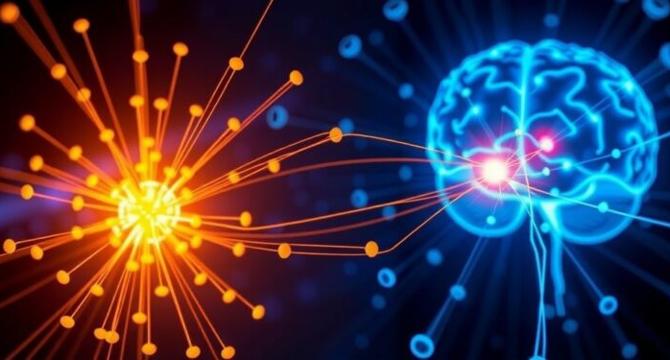Bioengineer
7d
315

Image Credit: Bioengineer
Breakthrough in Wireless Deep Brain Stimulation: Nanoparticle Technology Shows Promise in Reversing Parkinson’s Disease
- Researchers from the National Center for Nanoscience and Technology of the Chinese Academy of Sciences have developed and tested a wireless photothermal deep brain stimulation nanosystem designed to treat Parkinson’s disease (PD), which employs nanoparticle technology to target and stimulate degenerated neurons.
- The researchers, led by Professor CHEN Chunying, explained that the wireless system (known as Au@TRPV1@β-syn nanoparticles) achieves this by directly stimulating neurons' thermosensitive TRPV1 receptor using a photothermal conversion technique.
- The study saw applications of the nanoparticle technology to an α-syn fibril-induced model of PD in mice, with non-invasive treatment using the wireless nanosystem leading to restored dopaminergic neurons in the substantia nigra and noticeable improvements in motor function.
- The system doesn't require invasive surgical procedures, implants or neural electrodes, as it relies on endogenously expressed TRPV1 receptors. There is also an excellent biosafety profile, which suggests that the approach could be suitable for clinical use.
- The ATB NPs nanosystem uses gold nanoshells to activate TRPV1 using photothermal effects, while TRPV1 antibodies are used for targeting. Beta-syn peptides were included in the degradation module to facilitate the clearance of pathological α-syn fibrils.
- In the experiment, the ATB NPs were injected into the substantia nigra of PD model mice to anchor themselves to the surface of the dopaminergic neurons, resulting in the activation of the TRPV1 receptors and concurrent release of beta-syn peptides.
- There are hopes that the nanoparticle technology of the wireless DBS nanosystem could translate to a new era of treating PD and other neurodegenerative diseases.
- In this groundbreaking study, the wireless deep brain stimulation nanosystem using nanoparticles offers a non-invasive way of treating the degenerated neurons in Parkinson’s disease (PD), which is currently treated through invasive surgeries and implanted electrodes.
- The wireless system uses non-toxic and safe gold nanoshells and theranostic β-syn peptides to restore degenerated neurons in the substantia nigra, which significantly enhanced capacity for dopamine release leading to noticeable enhancements in the motor functions of PD model mice.
- The nanoparticle technology presents marked advantages over conventional methods, and this new approach could be viable for clinical use while minimising the risks associated with invasive procedures.
Read Full Article
18 Likes
For uninterrupted reading, download the app